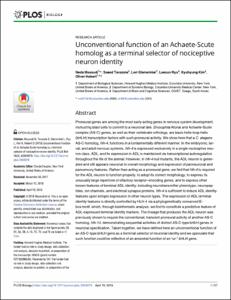Department of Brain Sciences
The K. Kim Lab of Neurobehavior and Neural Circuits
1. Journal Articles
Unconventional function of an Achaete-Scute homolog as a terminal selector of nociceptive neuron identity
- Title
- Unconventional function of an Achaete-Scute homolog as a terminal selector of nociceptive neuron identity
- Author(s)
- Masoudi, Neda ; Tavazoie, Saeed ; Glenwinkel, Lori ; Ryu, Lee sun ; Kim, Kyu Hyung ; Hobert, Oliver
- DGIST Authors
- Masoudi, Neda ; Tavazoie, Saeed ; Glenwinkel, Lori ; Ryu, Lee sun ; Kim, Kyu Hyung ; Hobert, Oliver
- Issued Date
- 2018-04
- Type
- Article
- Article Type
- Article
- Keywords
- CELL-TYPES ; CHEMICAL REPELLENTS ; REGULATORY LOGIC ; PRONEURAL GENE ; PROTEIN ; NEMATODE CAENORHABDITIS-ELEGANS ; HELIX TRANSCRIPTION FACTORS ; LIM HOMEOBOX GENE ; C-ELEGANS ; NERVOUS-SYSTEM
- ISSN
- 1544-9173
- Abstract
- Proneural genes are among the most early-acting genes in nervous system development, instructing blast cells to commit to a neuronal fate. Drosophila Atonal and Achaete-Scute complex (AS-C) genes, as well as their vertebrate orthologs, are basic helix-loop-helix (bHLH) transcription factors with such proneural activity. We show here that a C. elegans AS-C homolog, hlh-4, functions in a fundamentally different manner. In the embryonic, larval, and adult nervous systems, hlh-4 is expressed exclusively in a single nociceptive neuron class, ADL, and its expression in ADL is maintained via transcriptional autoregulation throughout the life of the animal. However, in hlh-4 null mutants, the ADL neuron is generated and still appears neuronal in overall morphology and expression of panneuronal and pansensory features. Rather than acting as a proneural gene, we find that hlh-4 is required for the ADL neuron to function properly, to adopt its correct morphology, to express its unusually large repertoire of olfactory receptor–encoding genes, and to express other known features of terminal ADL identity, including neurotransmitter phenotype, neuropeptides, ion channels, and electrical synapse proteins. hlh-4 is sufficient to induce ADL identity features upon ectopic expression in other neuron types. The expression of ADL terminal identity features is directly controlled by HLH-4 via a phylogenetically conserved E-box motif, which, through bioinformatic analysis, we find to constitute a predictive feature of ADL-expressed terminal identity markers. The lineage that produces the ADL neuron was previously shown to require the conventional, transient proneural activity of another AS-C homolog, hlh-14, demonstrating sequential activities of distinct AS-C-type bHLH genes in neuronal specification. Taken together, we have defined here an unconventional function of an AS-C-type bHLH gene as a terminal selector of neuronal identity and we speculate that such function could be reflective of an ancestral function of an “ur-” bHLH gene. © 2018 Masoudi et al.
- Publisher
- Public Library of Science
- Related Researcher
-
-
Kim, Kyuhyung
- Research Interests Neurobehavior; Neural Circuit; Neurodevelopment; 신경회로; 신경행동; 신경발생; 신경유전학
-
- Files in This Item:
-

10.1371_journal.pbio.2004979.pdf
기타 데이터 / 18.36 MB / Adobe PDF download
- Appears in Collections:
- Department of Brain Sciences The K. Kim Lab of Neurobehavior and Neural Circuits 1. Journal Articles



